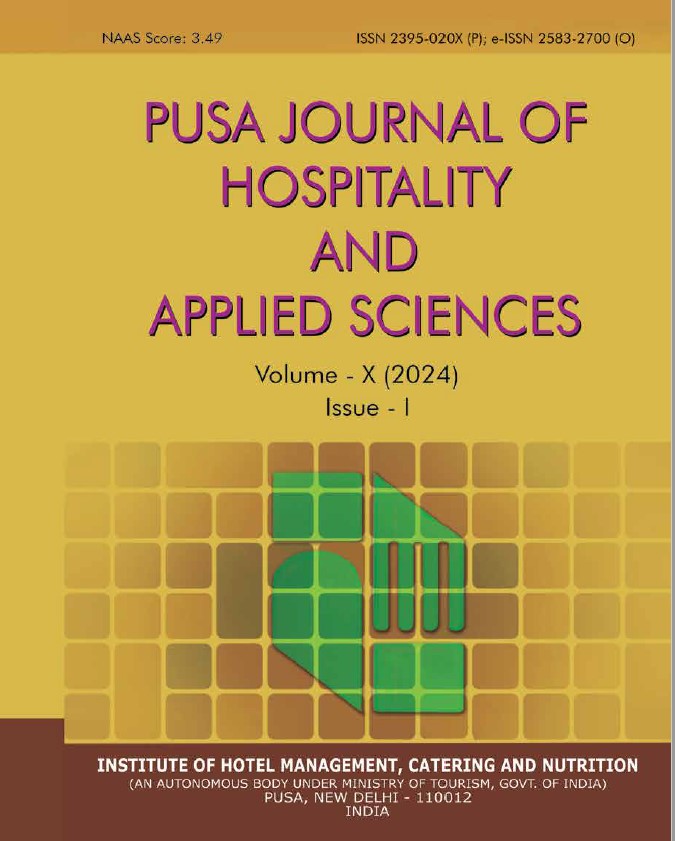Navigating Dietary Complexities: Understanding Gluten Intolerance Awareness among Stakeholders
DOI:
https://doi.org/10.48165/pjhas.2024.10.2.9Keywords:
Gluten free, gluten intolerance, food hypersensitivity, stakeholders, food business operators, alternatives, consumerAbstract
Background: Eating out is not only a common trend these days but also necessity for many who live away from their families especially students pursuing higher education. With growing trend of food hypersensitivity catering industry needs to get driven for such special requirement. Objective: This study aimed to check the awareness of stakeholders for gluten intolerance with respect to the market and sensory evaluation of the developed alternative. Methodology: A cross-sectional study was conducted on consumers and food business operators of Central Delhi. Consumers were 18 years and above and claiming to be gluten intolerant. Food business operators were local shopkeepers running food stalls and bakery. A self -structured questionnaire was designed for stakeholders respectively. Developed gluten alternative was sensory evaluated by consumers on 9-point hedonic rating scale for its overall acceptability. Data was analyzed for the stakeholders by using descriptive statistics. Results: The results indicate that majority (53.65%) consumers were familiar with the symptoms of gluten intolerance like headache and digestive issues. Furthermore, majority (68.3%) identified rice and corn to be an alternative for gluten. Level of satisfaction from market for availability of alternatives is medium (61%).Sensory score for developed alternative was 7.19 ±1.53. Regarding food business operators’ majority (53.12%) receive customer request for availability of gluten free products, 46.87% are affirmative to provide alternatives subjected to demand of consumers. 53.12% also showcased interest in receiving training or resources for gluten intolerance and lactose free cooking skills and outsourcing of such food items. Conclusion: In general stakeholders showcased awareness about their food intolerance and improved availability of alternatives in market. At the same time willingness of food business operators to offer such products on menu. The study recommends to provide training to food business operators for provision of diversified menu for prospective consumers.
References
Aljameel, G. M., AlSedairy, S. A., Binobead, M. A., Alhussain, M. H., Bin Obaid, M. A., Al-Harbi, L. N., Alshammari, G. M., & Arzoo, S. (2023). Awareness of Food Allergies and Allergens on the Menus of Restaurants and Cafes among Saudi Female University Students. Healthcare (Basel, Switzerland), 11(9), 1259. https://doi.org/10.3390/healthcare11091259
Barnett, J., Begen, F. M., Gowland, M. H., & Lucas, J. S. (2018). Comparing the eating out experiences of consumers seeking to avoid different food allergens. BMC Public Health, 18(1). https://doi.org/10.1186/
s12889-018-6117-y
Begen, F. M., Barnett, J., Payne, R., Roy, D., Gowland, M. H., & Lucas, J. S. (2016). Consumer preferences for written
and oral information about allergens when eating out. PLoS ONE, 11(5), e0156073. https://doi.org/10.1371/ journal.pone.0156073
Bhukya, R., & Paul, J. (2023). Social influence research in consumer behavior: What we learned and what we need to learn? – A hybrid systematic literature review. Journal of Business Research, 162, 113870. https://doi.
org/10.1016/j.jbusres.2023.113870
Common, L., Corrigan, C., Smith, H., Bailey, S., Harris, S., & Holloway, J. A. (2013). How safe is your curry? Food allergy awareness of restaurant staff. Journal of Allergy & Therapy, 4(4). https://doi.org/10.4172/2155-
6121.1000140
Conner, T. S., Mirosa, M., Bremer, P., & Peniamina, R. (2018). The Role of Personality in Daily Food Allergy Experiences. Frontiers in Psychology, 9. https://doi. org/10.3389/fpsyg.2018.00029
Endres, A. B., Endres, R., & Nižić, M. K. (2020). Working paper: restaurant disclosure of food allergens: analysis and economic implications. Tourism and Hospitality Research. https://doi.org/10.13012/b2idb-9891298_v1
Gupta, R., Siracusa, M., Yarbrough, M., & Smith, B. (2016). P278 Parental therapy preferences for children with food allergy. Annals of Allergy Asthma & Immunology, 117(5), S104. https://doi.org/10.1016/j.anai.2016.09.291
Hossny, E., Ebisawa, M., El-Gamal, Y., Arasi, S., Dahdah, L., El-Owaidy, R., Galvan, C. A., Lee, B. W., Levin, M., Martinez, S., Pawankar, R., Tang, M. L. K., Tham, E. H., & Fiocchi, A. (2019). Challenges of managing food allergy in the developing world. The World Allergy Organization journal, 12(11), 100089. https://doi.
org/10.1016/j.waojou.2019.100089
Kaya, A., Erkoçoğlu, M., Civelek, E., Çakır, B., & Kocabaş, C. N. (2013). Prevalence of confirmed IgE-mediated food allergy among adolescents in Turkey. Pediatric allergy and immunology: official publication of the European Society of Pediatric Allergy and Immunology, 24(5), 456–462. https://doi.org/10.1111/pai.12097
Krishna, M. T., Mahesh, P. A., Vedanthan, P., Moitra, S., Mehta, V., & Christopher, D. J. (2020). An appraisal of allergic disorders in India and an urgent call for action. World Allergy Organization Journal, 13(7), 100446. https://doi.org/10.1016/j.waojou.2020.100446
Kumar, T., & Sharma, S. (2020). Development of pizza base using functional ingredients. PUSA Journal of Hospitality and Applied Sciences, 6, 81-93.
Makharia, G. K., Verma, A. K., Amarchand, R., Bhatnagar, S., Das, P., Goswami, A., Bhatia, V., Ahuja, V., Gupta, S. D., & Anand, K. (2010). Prevalence of celiac disease in the northern part of India: A community based study. Journal of Gastroenterology and Hepatology, 26(5), 894–900. https://doi.org/10.1111/j.1440-1746.2010.06606.x
Masih, J., Verbeke, W., Deutsch, J., Sharma, A., Sharma, A., Rajkumar, R., & Matharu, P. S. (2019). Big Data Study for Gluten-Free Foods in India and USA Using Online Reviews and Social Media. Agricultural Sciences, 10(03), 302–320. https://doi.org/10.4236/ as.2019.103026
Morita, Y., Iwakura, H., Ohtsuka, H., Kohno, Y., & Shimojo, N. (2013). Milk allergy in the neonatal intensive care unit: comparison between premature and full-term neonates. Asia Pacific Allergy, 3(1), 35–41. https://doi.
org/10.5415/apallergy.2013.3.1.35
Soós, G., & Lugasi, A. (2024). Consumer attitude research regarding food hypersensitivity. International Journal of Gastronomy and Food Science, 36, 100918. https://doi. org/10.1016/j.ijgfs.2024.100918
Venter, C., Laitinen, K., & Vlieg-Boerstra, B. (2012). Nutritional aspects in diagnosis and management of food hypersensitivity-the dietitians role. Journal of Allergy, 269376. https://doi.org/10.1155/2012/269376
Versluis, A., Knulst, A. C., Kruizinga, A. G., Michelsen, A., Houben, G. F., Baumert, J. L., & Van Os‐Medendorp, H. (2014). Frequency, severity and causes of unexpected allergic reactions to food: a systematic literature review. Clinical & Experimental Allergy, 45(2), 347–367. https://doi.org/10.1111/cea.12328
Wen, H., & Kwon, J. (2017). Restaurant servers’ risk perceptions and risk communication-related behaviors when serving customers with food allergies in the U.S. International Journal of Hospitality Management, 64, 11–20. https://doi.org/10.1016/j.ijhm.2017.03.009
Yue, D., Ciccolini, A., Avilla, E., & Waserman, S. (2018). Food allergy and anaphylaxis. Journal of Asthma and Allergy, 11, 111–120. https://doi.org/10.2147/JAA. S162456




